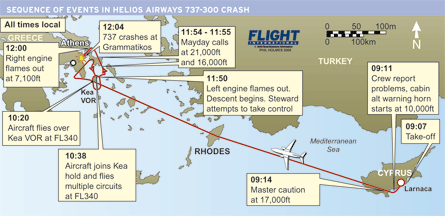Arguments and controversy surround crash report as airline and aviation authorities feel the sting of criticism
Flight data recorder (FDR) information from the Helios Airways crash proves that crew and passengers gradually lost consciousness from lack of oxygen as cabin altitude increased almost in line with the 737-300's height, as the aircraft climbed from Larnaca, Cyprus.
This is clear from the FDR download from the 14 August 2005 accident carried out by the French investigation agency BEA for the Hellenic Air Accident Investigation and Aviation Safety Board (AAIASB)'s just-published final report on the crash near Grammatikos, Greece.

Similarly, when the aircraft ran out of fuel and began its descent after being flown over almost its entire route toward Athens by the pre-programmed flight management system/autopilot, the FDR traces of cabin and aircraft altitude shown in the report also coincided. The report reveals that, during the aircraft's final 30min, the cockpit voice recorder (CVR) tape playback was dominated by the continual sound of the cabin altitude warning horn, which stopped 44s before impact as the aircraft descended through 10,000ft altitude.
The FDR printout indicates the warning horn had operated continuously from the time it was first triggered during the climb. About 5min before the aircraft crashed into a hillside, the CVR records three progressively weakening attempts - believed to have been made by a steward who gained access to the flightdeck - to transmit mayday calls to Athens.
The radio, however, was still set to the Nicosia, Cyprus frequency, as it had been when the pilots lost consciousness. Four minutes before the 737 crashed, the CVR records three overspeed alerts and, finally, four altitude alerts.
What caused the crash?The Air Accident Investigation and Aviation Safety Board (AAIASB) of the Hellenic Ministry of Transport and Communications has listed three "direct" and four "latent" causes of the 14 August 2005 Helios Airways Boeing 737-300 accident. The crash resulted in the death of all 115 passengers and six crew. "Direct" causes are described as:
|
|---|
This simple data has considerable significance in the airline's country of registration, Cyprus, because before and also since the report was published, Helios representatives - including the airline's lawyer Demetris Araouzos - have questioned the credibility of the accident report's primary contention: that the pilots failed to notice the aircraft's failure to pressurise as it climbed. The airline has contended that it would have been impossible for the pilots not to have noticed the physical sounds and symptoms of failure to pressurise if it had occurred - as stated in the report - because the pressurisation mode control switch was set to manual instead of automatic. Yet non-volatile memory in the unit has proved that the controls were indeed set to manual during the flight.
Again, since the report's publication, Helios's lawyers have criticised the chief investigator Akrivos Tsolakis for not making specific safety recommendations to the airline - now known as Ajet - despite the fact that his report says deficiencies in airline management were "latent" causes of the accident. Asked why he did not make recommendations for the carrier, he has said the airline that existed then does not exist now, commenting: "We cannot deal with ghosts."
The controversy has mainly come from the report's contention that failure by an airline maintenance team to reset the mode control from manual to automatic after a ground test "could have contributed" to the accident. Pre-flight checklists performed by the pilots, however, require them to check and select the correct settings for the pressurisation system, and the report makes clear the pilots did not carry out these checks effectively.
Meanwhile, the report also criticises the Cyprus Department of Civil Aviation (DCA) for its lack of safety oversight of Helios's maintenance documentation and operational practises. There are 11 recommendations intended to reduce the chances of a similar event occurring, and these are aimed across the board at the DCA, the European Aviation Safety Agency, the European Joint Aviation Authorities, and the International Civil Aviation Organisation.
Tsolakis makes it clear he thinks that agencies like these have failed to anticipate the degree of risk associated with failure to pressurise, and therefore to set appropriate standards and recommended practices for manufacturers and airlines to meet.
Source: Flight International







































